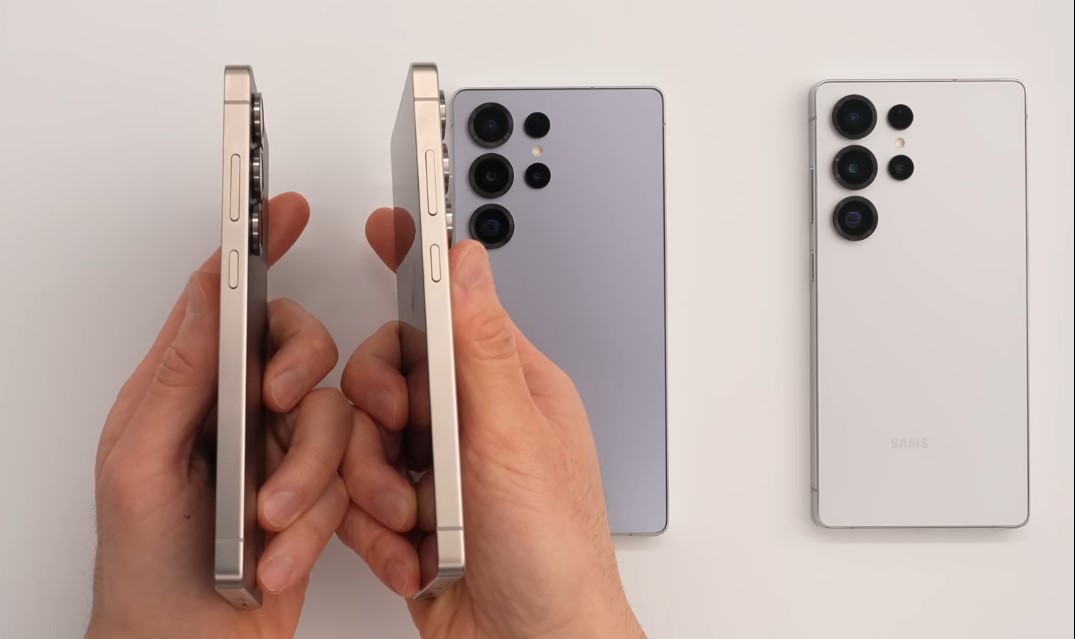Visual excerpt from the YouTube channel Dave2D. All rights belong to the original creator.
Samsung has unveiled its Galaxy S25 lineup, consisting of the S25, S25 Plus, and S25 Ultra. The series introduces key refinements that aim to balance sleek aesthetics with cutting-edge technology. Starting at 12GB of RAM across all models, pricing remains consistent with last year’s models, making this an accessible upgrade for loyal fans.
A New Shape for the Ultra Model
One of the most noticeable changes is the design overhaul of the Galaxy S25 Ultra. Unlike the rounded edges seen in previous generations, the S25 Ultra now boasts completely flat sides. This design mirrors the look and feel of standard S25 devices, lending it a modern yet somewhat generic aesthetic. While the flat design offers excellent grip and comfort, it might leave fans of Samsung’s signature rounded edges longing for the past.
In contrast, the S25 and S25 Plus models remain relatively unchanged from their S24 predecessors. The biggest tell-tale sign is the subtle concentric rings around the camera lenses, a small yet distinct difference.
Enhanced Display Technology
The S25 Ultra introduces a larger screen with thinner bezels, enhanced with slightly more rounded corners. Although it maintains a peak brightness of 2600 nits and a 120 Hz QHD+ LTPO panel for dynamic refresh rates between 1 Hz and 120 Hz, it doesn’t break any new ground in brightness capabilities. However, the inclusion of Gorilla Glass Armor 2 significantly improves durability, ensuring resistance to scratches and fractures.
Samsung has also adjusted the anti-reflective coating, offering a slight improvement in reducing glare, making the screen appear even sharper under direct light. This feature, exclusive to the Ultra models, continues to emphasize Samsung’s commitment to premium user experiences.
A Broader Spectrum of Colors
The Ultra lineup presents five stunning titanium-themed colors: black, gray, silver, blue, and white. Each color is paired with frames designed to complement the aesthetic. The gray variant, in particular, stands out as a fan favorite for its natural metallic hue. Meanwhile, the S25 and S25 Plus offer more playful options, including Silver Shadow, Mint, Icy Blue, and Navy. The attention to matching device and frame colors creates a cohesive design that’s visually appealing across the board.
Internal Upgrades for Performance and Efficiency
Under the hood, the S25 lineup is powered by the Snapdragon 8 Elite chipset, featuring enhanced vapor chamber cooling for better thermal management. In testing, this chipset demonstrates improved energy efficiency, with battery life estimated to be 25–30% better than its predecessor.
Interestingly, despite no increase in battery size—remaining at 5,000 mAh for the Ultra model—the improved energy efficiency ensures longer usage times. Still, competitors offering batteries in the 6,000 mAh range put the S25 Ultra at a slight disadvantage for heavy users.
Refinements in Camera and S Pen Features
The camera system in the Ultra model sees significant upgrades. Its ultra-wide lens now uses a 50MP sensor, and the device introduces support for shooting in log format. This advanced feature offers professional-grade video recording with adjustable light data for post-processing.
However, a surprising omission in the S25 Ultra is Bluetooth capability in its S Pen. Unlike previous models, users can no longer use the pen to remotely control camera functions or perform air gestures. While this might not impact everyday use for most, power users who relied on these features may feel the loss keenly. Speculation suggests this could be an attempt by Samsung to promote its ecosystem, encouraging customers to opt for Samsung watches as an alternative for remote camera control.
MPP Case and MagSafe Compatibility
Samsung introduces the MPP case, which includes a ring of magnets in the center, granting MagSafe charging capabilities. Paired with Samsung’s wireless chargers, this case enables seamless Qi2 wireless charging. It’s a noteworthy step for Samsung, allowing users to enjoy the convenience of magnetic charging options popularized by competitors.
Groundbreaking AI Features in One UI 7
Samsung’s One UI 7 takes advantage of AI to redefine efficiency. The most impressive new feature is the introduction of two-step AI tasks, such as checking weather conditions before adjusting alarms or calculating travel time and sending automatic notifications.
For instance, the S25 can recognize snow forecasts to wake users earlier or combine travel data with calendar scheduling. While pre-release testing indicated occasional reliability issues, the concept highlights how AI can save significant time for multitaskers.
Though currently exclusive to the S25 family, Samsung is likely to roll out these innovations to older devices in the future, ensuring a broader audience can benefit from this technology.
The Verdict on the Galaxy S25 Lineup
Samsung’s S25 series maintains its position at the forefront of smartphone innovation, particularly with the Ultra model. By blending enhanced durability, improved battery efficiency, professional-grade cameras, and meaningful AI integrations, the S25 family addresses the diverse needs of modern users.
While the loss of features like Bluetooth-enabled S Pens might surprise long-time fans, the addition of new capabilities, such as the MPP case and advanced AI features, underscores Samsung’s forward-thinking strategy.
The full potential of the Galaxy S25 lineup will undoubtedly unfold with time, especially as users explore these features in their day-to-day lives. However, Samsung’s decision to maintain the same price while offering tangible improvements makes this lineup a compelling choice for 2025.
For more insights, stay tuned for a deep dive into the Galaxy S25 Ultra’s performance and camera capabilities in the upcoming review.



















